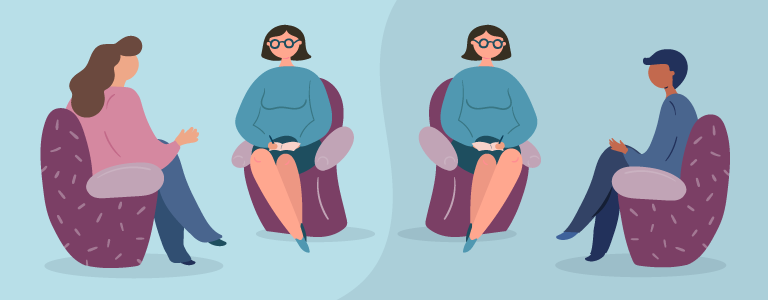How to Address Weight Bias and Weight Discrimination

At a casual dinner out, Maria Rago was enjoying the company of her friend when their food arrived. Once their meals were served, her friend gave a sheepish look and said he was “really sorry” for what he’d ordered.
“He apologized because he felt his meal was not healthy enough,” Rago said.
Rago, who serves as the board president of the National Association of Anorexia Nervosa and Associated Disorders (ANAD), is no stranger to toxic but widely shared perceptions about eating.
She said that her friend’s “shame and fear of being judged came from his own personal history with eating and food,” as well as how he’s been treated socially.
Americans are obsessed with weight, spurred by unrealistic beauty ideals and the narrative that slimness indicates health.
Americans are obsessed with weight, spurred by unrealistic beauty ideals and the narrative that slimness indicates health. Unlike characteristics such as race and sexuality, weight can be perceived as being within a person’s control, fueling negative stereotyping, stigma, and bias against people of different sizes. People who don’t meet society’s beauty standards, because they are perceived as being too big or too skinny, can be ostracized and discriminated against.
In a study published in the International Journal of Obesity, researchers found that the prevalence of weight discrimination ranged between 5% among men to 10% among women. That number jumped to approximately 40% for heavier individuals.
For those in helping professions like social work, it’s imperative to teach others to communicate positive messages about body image in a more compassionate and less judgmental manner.
For those in helping professions like social work, it’s imperative to teach others to communicate positive messages about body image in a more compassionate and less judgmental manner. This can help humanize people of different sizes and support their health journeys. Experts say it’s also important for professionals to tackle their own implicit biases and recognize that there may be external and often uncontrollable factors that can influence someone’s weight.
What Are Weight Bias and Weight Discrimination?
Weight bias stems from negative weight-related attitudes toward people of different sizes, which can result in discriminatory treatment. It tends to develop earlier in life and is affected by sociocultural ideals created by the media, peers and family members. A study on body size stereotyping among preschool girls from 2010 found that 3-year-old girls were already emotionally invested in the thin ideal.
People who are overweight or obese may be unfairly stereotyped as lazy, overindulgent and undisciplined, said Michelle Smith, a social worker who specializes in size justice, fighting oppression and marginalization of people of different sizes. Meanwhile, those with eating disorders may be more likely to be considered obsessive, perfectionist, rigid and ritualized.
“Society is full of judgment for people with eating disorders because they think certain behaviors, like eating to the point where you would throw up, are irrational,” Rago said. “The fear people have toward obesity internalizes into a critical and hateful voice, which is what people with eating disorders go through.”
People who are viewed as too big can experience weight bias and discrimination in sectors such as:

EMPLOYMENT
The stigma against weight is one of the last few socially acceptable biases, lacking any federal protection against discrimination. For example, under Title VII of the Civil Rights Act of 1964, employer discrimination against an individual’s race, color, religion, sex or national origin is prohibited. However, people of different sizes, especially people with obesity, are not included. In fact, people with obesity are less likely to be hired, promoted or earn a raise at the workplace, according to a 2012 literature review published in Obesity.

SOCIAL LIFE
The same article indicated that peer rejection is one of the biggest challenges to emerge from weight bias and can begin to develop around the age of eight. In a study assessing perceived weight stigma among overweight teenage girls, 96% of them reported negative weight-related experiences and comments.

EDUCATION
In a 1999 study assessing beliefs and attitudes about obesity among teachers and school health care providers working with adolescents, between 20% to 25% of respondents perceived people with obesity as “more emotional, less tidy, less likely to succeed at work, … or having more family problems than [people without obesity].”

HEALTH CARE
Studies have shown that primary care physicians have less emotional rapport with overweight and obese patients, which interferes with health outcomes. They also spend less time with patients of larger sizes.
According to a 2011 article in American Journal of Public Health (AJPH), stigmatizing obesity threatens public health and can result in:
- Avoidance of addressing the social and environmental contributors to obesity.
- Impaired obesity prevention efforts.
- Increased health disparities.
- Exacerbated social inequalities and unfair treatment.
- Lower participation in physical activity.
- Heightened risk for developing eating disorders and depression.
Furthermore, on an interpersonal level, weight bias lowers self-esteem and creates more stress. Those affected may be more reluctant to seek care or may not receive the appropriate treatment. According to an article published in the Journal for Nurse Practitioners, women who internalized weight stigma reported that they were more likely to binge-eat and less likely to diet.
When addressing people with obesity, Emily Dhurandhar, a spokesperson for the Obesity Society, said there’s a certain type of pain that comes with being marginalized.
“We’re talking about 35% of the population that [is] being forced to sit outside of society as not active members, as not respected for their talents or their abilities,” she said. “These people call in sick more often and aren’t as likely to participate in social activities.”
How Can Social Workers Confront Their Own Weight Bias?

Social workers serve vulnerable populations and may be better positioned to recognize factors that contribute to weight loss or gain and are rooted in community, family and personal history or trauma.
Smith pointed to low-income neighborhoods as an example: Residents in these neighborhoods may have less access to transportation to supermarkets, which provide whole, fresh produce and nutritious foods. These residents may be forced to shop at corner stores, where there are less healthy options and food is overall more expensive than purchasing at a big-box store. Additionally, families who take advantage of food pantries may find them stocked with shelf-stable, non-perishable goods that often fall toward the unhealthier end of the spectrum. In urban communities, there may also be fewer green spaces, limiting opportunities to engage in physical or recreational activities.
Social workers can meet clients where they are and develop individual plans that address challenging social or environmental circumstances.
“I think when social workers venture into these communities assisting with issues like housing and domestic violence, we need to add weight to that narrative,” Smith said. “If someone is engaging in destructive health behaviors, we also need to look at certain determinants and behavior surrounding food.”
It’s the ability to look at the bigger picture that puts social workers in a unique position to address issues related to weight from a holistic perspective.
It’s the ability to look at the bigger picture that puts social workers in a unique position to address issues related to weight from a holistic perspective, Smith said.
But she also said that social workers have to examine their own implicit biases toward weight. For example, they need to ask themselves if they believe that people with obesity are automatically unhealthy and lazy, because those beliefs will inform how they speak to clients.
Acknowledging how internalized messages from society about weight might affect relationships with clients is the first step in overcoming bias. The aforementioned Journal for Nurse Practitioners article provides a list of questions that social workers can ask themselves.
How to Identify Your Own Weight Bias
- “Do I make assumptions based only on weight regarding a person’s character, intelligence, professional success, health status or lifestyle behaviors?”
- “Am I comfortable working with people of all shapes and sizes?”
- “Do I give appropriate feedback to encourage healthy behavioral change?”
- “Am I sensitive to the needs and concerns of people of different sizes?”
- “Do I treat the individual or only the condition?”
“It’s really our naïve assumptions about the way weight, shape and eating work that are at the root of bias,” Rago said. “We’re just not aware of the discrimination we have because we either justify them based on stereotype, or we haven’t really thought about those questions.”
How to Support Clients with Weight-Related Conditions
While there isn’t necessarily anything wrong with telling a client to practice better nutritional habits, it’s important to shift the conversation to focus on healthy behaviors, not simply weight loss or gain. There are a number of tactics social workers can use:
Try perspective-taking exercises. Conduct a role-playing scenario of social worker and client. Analyze language that’s used from different perspectives and discuss it after. Implement a zero-tolerance policy for negative comments. Use less-stigmatizing terms like unhealthy weight and high BMI, rather than fat or morbidly obese. Use supportive language. Using people-first language (i.e., “person with obesity” as opposed to “obese person”) can make a considerable difference in minimizing stigma. Allow the client to dictate what feels comfortable. Ask questions like, “Could we talk about your weight today?” “How do you feel about your weight?” “What words would you like to use when we talk about weight?” Don’t assume. Harmful blanket statements like “Maybe you should eat less fast food” are presumptuous and potentially unrelated to the individual client at hand. Emphasize achievable goals. Instead of saying, “You need to lose or gain weight,” suggest starting an exercise program or eating at home.By being sensitive to the individual needs of each client about their relationship with their weight, social workers can improve health outcomes and shift fault away from personal willpower or lack of discipline. Social workers will need to see beyond stereotypes in order to provide the same support and care regardless of weight because, as Smith reminds those in her profession, “size justice is a human right.”
If you’re interested in pursuing a career in social work, read more about how to become a licensed clinical social worker and check out our MSW programs with a clinical social work concentration.
Information on OnlineMSWPrograms.com is not intended to be a substitute for professional medical advice. Always consult your physician or other qualified professionals with any questions you may have regarding a potential eating disorder.
Last Updated: April 2020

